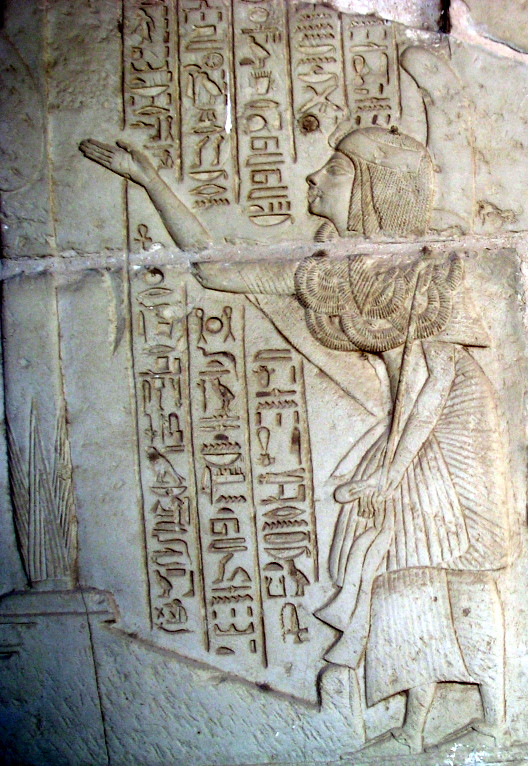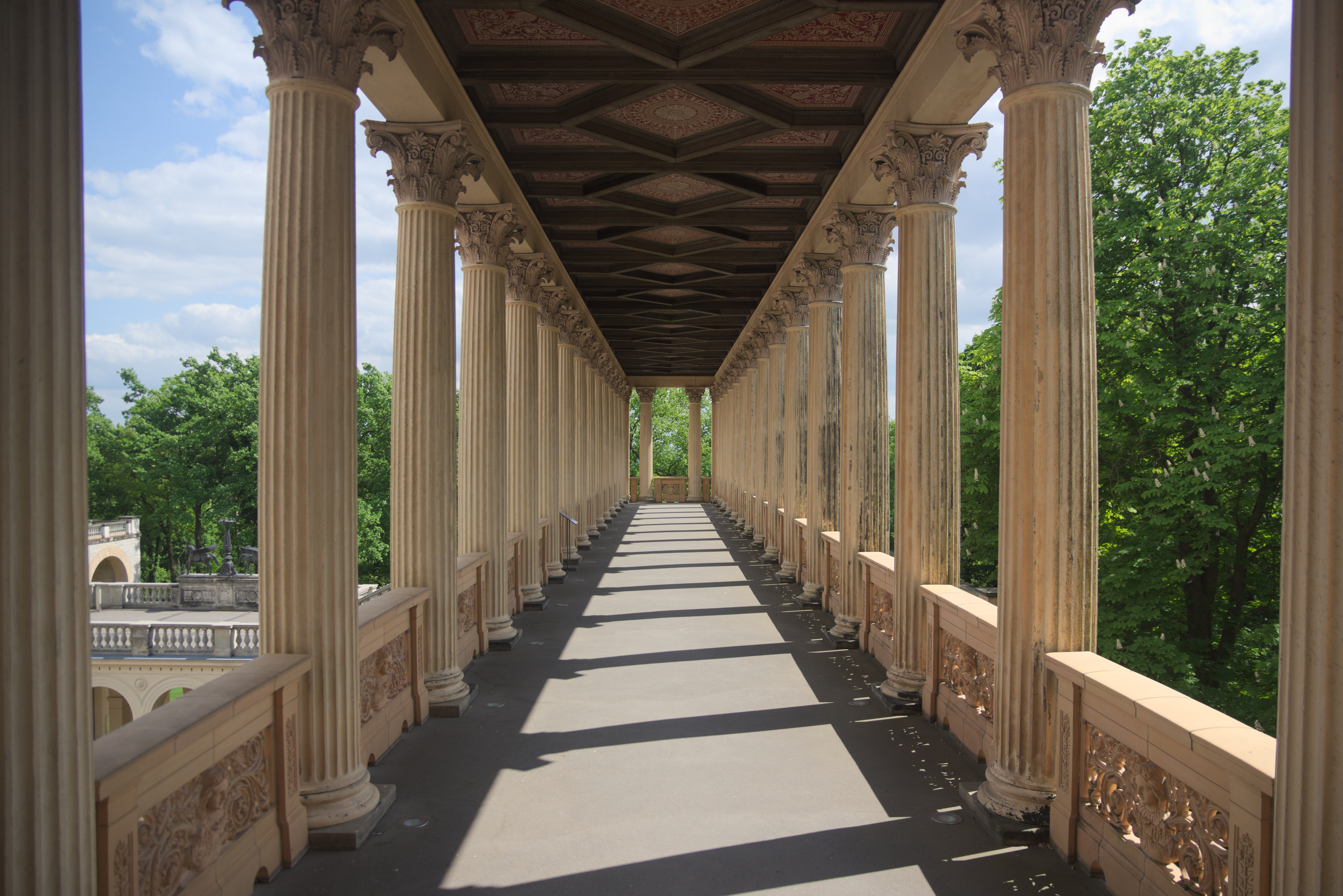|
Tomb Of Horemheb In Saqqara
The Memphite Tomb of Horemheb is located in the Saqqara necropolis, near Memphis, Egypt. It was constructed before Horemheb ascended to the throne and was never used for his burial, since he later built the Theban tomb KV57 for this purpose. His two wives Mutnedjmet and Amenia were buried within the structure. The tomb was discovered by art robbers at the beginning of the 19th century. Looted reliefs were acquired by a number of European and American museums. The tomb's location was then lost. It was relocated in 1975 and excavated in 1979. Building plans The tomb was built in three phases, as Horemheb's status rose. The first design consisted of an entry pylon into forecourt, a colonnaded court containing the burial shaft and three chapels or offering rooms. Intrusive burials were found in the side chapels. The forecourt was then walled to produce two small chapels, one at each side. They were entered by two new piercings through the pylon. A new walled forecourt was const ... [...More Info...] [...Related Items...] OR: [Wikipedia] [Google] [Baidu] |
KV57
Tomb KV57 is the royal tomb of Horemheb, the last pharaoh of the Eighteenth Dynasty of Egypt, Eighteenth Dynasty and is located in the Valley of the Kings, Egypt. The tomb was located by Edward R. Ayrton, Edward Ayrton in February 1908 for Theodore M. Davis, Theodore Davis. Due to its location in the valley floor, the tomb was filled with debris that had washed down during occasional flash-flooding. The tomb is markedly different from previous Eighteenth Dynasty royal tombs as it has a straightened axis, and has painted reliefs instead of murals; the Book of Gates also appears for the first time. The king's red granite sarcophagus was found with its lid broken, though otherwise intact. The tomb contained the remains of several burials, none of them conclusively belonging to Horemheb. Layout The tomb consists of a descending entrance stair, a sloping passageway leading to another descending stair, and another passageway that ends in a well shaft. Beyond the well chamber is the fir ... [...More Info...] [...Related Items...] OR: [Wikipedia] [Google] [Baidu] |
British Museum
The British Museum is a Museum, public museum dedicated to human history, art and culture located in the Bloomsbury area of London. Its permanent collection of eight million works is the largest in the world. It documents the story of human culture from its beginnings to the present.Among the national museums in London, sculpture and decorative art, decorative and applied art are in the Victoria and Albert Museum; the British Museum houses earlier art, non-Western art, prints and drawings. The National Gallery holds the national collection of Western European art to about 1900, while art of the 20th century on is at Tate Modern. Tate Britain holds British Art from 1500 onwards. Books, manuscripts and many works on paper are in the British Library. There are significant overlaps between the coverage of the various collections. Established in 1753, the British Museum was the first public national museum. In 2023, the museum received 5,820,860 visitors, 42% more than the previous y ... [...More Info...] [...Related Items...] OR: [Wikipedia] [Google] [Baidu] |
Uraeus
drawing of a Uraeus The Uraeus () or Ouraeus (Ancient Greek: , ; Egyptian: ', "rearing cobra", plural: ''Uraei'') is the stylized, upright form of an Egyptian cobra, used as a symbol of sovereignty, royalty, deity and divine authority in ancient Egypt. Symbolism The Uraeus is a symbol for the goddess Wadjet.Egyptian-Gods She was one of the earliest Egyptian deities and was often depicted as a cobra, as she is the serpent goddess. The center of her cult was in Per-Wadjet, later called Buto by the Greeks. She became the patroness of the Nile Delta and the protector of all of Lower Egypt. The pharaohs wore the uraeus as a head ornament: either with the body of Wadjet atop the head, or as a crown encircling the head; this indicated Wadjet's protection and reinforced the pharaoh's claim over the land. In whatever manner that the Uraeus was displayed upon the pharaoh's head, it was, in effect, part of the pharaoh's crown. The pharaoh was recognized only by wearing the Uraeus, whi ... [...More Info...] [...Related Items...] OR: [Wikipedia] [Google] [Baidu] |
Tutankhamun
Tutankhamun or Tutankhamen, (; ), was an Egyptian pharaoh who ruled during the late Eighteenth Dynasty of Egypt, Eighteenth Dynasty of ancient Egypt. Born Tutankhaten, he instituted the restoration of the traditional polytheistic form of ancient Egyptian religion, undoing a previous shift to the religion known as Atenism. Tutankhamun's reign is considered one of the greatest restoration periods in ancient Egyptian history. His endowments and restorations of cults were recorded on what is today known as the Restoration Stela. The cult of the god Amun at Thebes, Egypt, Thebes was restored to prominence, and the royal couple changed their names to "Tutankhamun" and "Ankhesenamun", replacing the -aten suffix. He also moved the royal court from Akhenaten's capital, Amarna, back to Memphis, Egypt, Memphis almost immediately on his accession to the kingship. He reestablished diplomatic relations with the Mitanni and carried out military campaigns in Nubia and the Near East. Tutankh ... [...More Info...] [...Related Items...] OR: [Wikipedia] [Google] [Baidu] |
Peristyle
In ancient Ancient Greek architecture, Greek and Ancient Roman architecture, Roman architecture, a peristyle (; ) is a continuous porch formed by a row of columns surrounding the perimeter of a building or a courtyard. ''Tetrastoön'' () is a rarely used archaic term for this feature. The peristyle in a Greek temple is a ''peristasis (architecture), peristasis'' (). In the Christian Church architecture, ecclesiastical architecture that developed from the Roman basilica, a courtyard peristyle and its garden came to be known as a cloister. Etymology The Greek word περίστυλον ''perístylon'' is composed of περί ''peri'', "around" or "surrounded", and στῦλος ''stylos'', "column" or "pillar", together meaning "surrounded by columns/pillars". It was Latinised into synonyms ''peristylum'' and ''peristylium''. In Greek architecture A peristyle was mostly used as a courtyard in Ancient Greece, but in the homes of people who were in the upper class or if they owned s ... [...More Info...] [...Related Items...] OR: [Wikipedia] [Google] [Baidu] |
19th Dynasty
The Nineteenth Dynasty of Egypt (notated Dynasty XIX), also known as the Ramessid dynasty, is classified as the second Dynasty of the Ancient Egyptian New Kingdom period, lasting from 1292 BC to 1189 BC. The 19th Dynasty and the 20th Dynasty furthermore together constitute an era known as the ''Ramesside period''. This Dynasty was founded by Vizier Ramesses I, whom Pharaoh Horemheb chose as his successor to the throne. History Background The warrior kings of the early 18th Dynasty had encountered only little resistance from neighbouring kingdoms, allowing them to expand their realm of influence easily, but the international situation had changed radically towards the end of the dynasty. The Hittites had gradually extended their influence into Syria and Canaan to become a major power in international politics, a power that both Seti I and his son Ramesses II would confront in the future. 19th Dynasty Seti I and Ramesses II The New Kingdom of Egypt reached the zenith ... [...More Info...] [...Related Items...] OR: [Wikipedia] [Google] [Baidu] |
Mastaba
A mastaba ( , or ), also mastabah or mastabat) is a type of ancient Egyptian tomb in the form of a flat-roofed, rectangular structure with inward sloping sides, constructed out of mudbricks or limestone. These edifices marked the burial sites of many eminent Egyptians during Egypt's Early Dynastic Period and Old Kingdom. Non-royal use of mastabas continued for over a thousand years. The word ''mastaba'' comes from the Arabic word (maṣṭaba) "stone bench". The Ancient Egyptian name was pr- Djt, meaning "house of stability", " house of eternity", or "eternal house". History The afterlife was centralized in the religion of ancient Egyptians. Their architecture reflects this, most prominently by the enormous amounts of time and labor involved in building tombs. Ancient Egyptians believed that the needs from the world of the living would be continued in the afterlife; it was therefore necessary to build tombs that would fulfill them, and be sturdy enough to last for an eter ... [...More Info...] [...Related Items...] OR: [Wikipedia] [Google] [Baidu] |
6th Dynasty
The Sixth Dynasty of ancient Egypt (notated Dynasty VI), along with the Third, Fourth and Fifth Dynasty, constitutes the Old Kingdom of Dynastic Egypt. History The Sixth Dynasty is considered by many authorities as the last dynasty of the Old Kingdom, although ''The Oxford History of Ancient Egypt'' includes Dynasties VII and VIII as part of the Old Kingdom. Manetho writes that these kings ruled from Memphis, since their pyramids were built at Saqqara, very close one to another. By the Fifth Dynasty, the religious institution had established itself as the dominant force in society; a trend of growth in the bureaucracy and the priesthood, and a decline in the pharaoh's power had been established during Neferirkare Kakai's reign. During Djedkare Isesi's rule, officials were endowed with greater authority—evidenced by the opulent private tombs they constructed—eventually leading to the creation of a feudal system in effect. These established trends—decentralization of ... [...More Info...] [...Related Items...] OR: [Wikipedia] [Google] [Baidu] |
Colonnade
In classical architecture, a colonnade is a long sequence of columns joined by their entablature, often free-standing, or part of a building. Paired or multiple pairs of columns are normally employed in a colonnade which can be straight or curved. The space enclosed may be covered or open. In St. Peter's Square in Rome, Bernini's great colonnade encloses a vast open elliptical space. When in front of a building, screening the door (Latin ''porta''), it is called a portico. When enclosing an open court, a peristyle. A portico may be more than one rank of columns deep, as at the Pantheon in Rome or the stoae of Ancient Greece. When the intercolumniation is alternately wide and narrow, a colonnade may be termed "araeosystyle" (Gr. αραιος, "widely spaced", and συστυλος, "with columns set close together"), as in the case of the western porch of St Paul's Cathedral St Paul's Cathedral, formally the Cathedral Church of St Paul the Apostle, is an Anglican c ... [...More Info...] [...Related Items...] OR: [Wikipedia] [Google] [Baidu] |
Pylon (architecture)
A pylon is a monumental gate of an Egyptian temple (Egyptian: ''bxn.t'' in the Manuel de Codage transliterationErmann & Grapow, ''Wörterbuch der ägyptischen Sprache'', vol.1, 471.9–11). The word comes from the Greek term 'gate'. It consists of two pyramidal towers, each tapered and surmounted by a cornice, joined by a less elevated section enclosing the entrance between them.Toby Wilkinson, ''The Thames and Hudson Dictionary of Ancient Egypt'', Thames & Hudson, 2005. p.195 The gate was generally about half the height of the towers. Contemporary paintings of pylons show them with long poles flying banners. Egyptian architecture In ancient Egyptian religion, the pylon mirrored the hieroglyph ''akhet'' 'horizon', which was a depiction of two hills "between which the sun rose and set". Consequently, it played a critical role in the symbolic architecture of a building associated with the place of re-creation and rebirth. Pylons were often decorated with scenes emphasizing ... [...More Info...] [...Related Items...] OR: [Wikipedia] [Google] [Baidu] |






